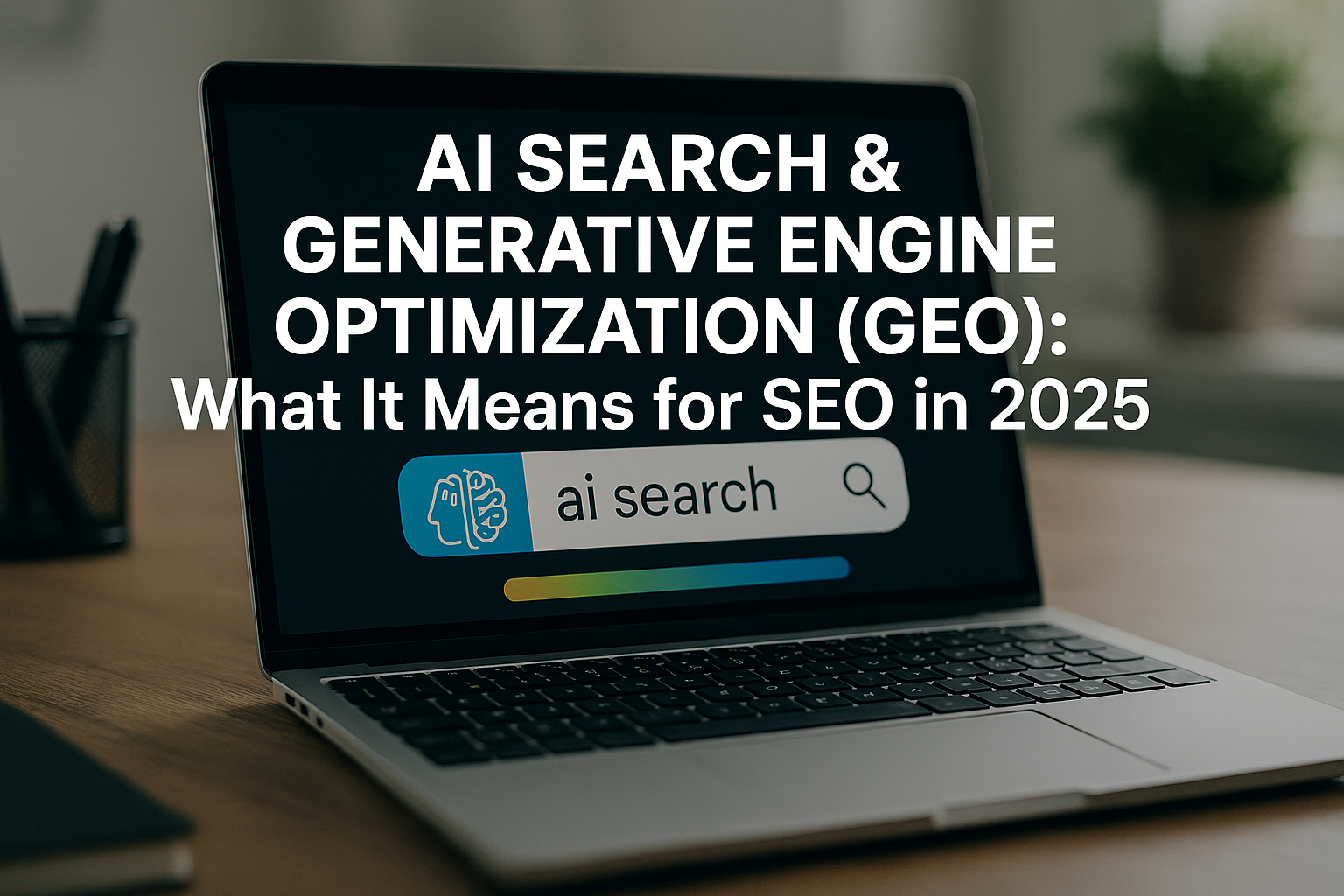AI Search & Generative Engine Optimization (GEO): What It Means for SEO in 2025

The search landscape is undergoing a paradigm shift. With the rise of AI search engines, large language models (LLMs), and conversational generative interfaces (such as ChatGPT, Google’s SGE, Gemini, Perplexity, etc.), traditional SEO tactics are being challenged. In 2025, Generative Engine Optimization (GEO) is emerging as a must-have strategy for brands that want visibility in AI-powered responses, summaries, and “answer engines.”
In this article, we explore what GEO means, why it matters, how it differs from classic SEO, and concrete strategies you can use to succeed in this new era.
What is Generative Engine Optimization (GEO)?
Generative Engine Optimization (GEO) refers to the practice of optimizing content, website structure, citations, and authority signals so that content appears in AI-generated answers or summaries. This includes AI overviews (e.g. Google’s SGE), AI chatbots responses, generative search results, and other forms of answer engine output.
Key components of GEO include:
-
Ensuring content is AI-readable and semantically rich.
-
Using structured data, schema markup, FAQs, Q&A, citations, and statistics to make content credible and citable.
-
Building authority and trust through online reviews, directories, third-party mentions & earned media.
-
Making sure that technical website factors (site speed, crawlability, correct robots settings, schema, etc.) are optimized for AI agents.
How GEO Differs from Traditional SEO
| Factor | Traditional SEO | Generative Engine Optimization (GEO) |
|---|---|---|
| Goal | Rank higher in SERP listings, drive organic traffic via clicks | Get content cited or used in AI answers; increase visibility inside AI overviews & chatbots |
| Keyword focus | Exact match & long-tail keywords; keyword density | Semantic keywords, entities, synonyms, intent, context |
| Authority building | Backlinks, domain authority, link volume | Earned citations, mentions from UGC / trusted sources, being listed in directories & other high-trust sources |
| Content format | Content made for users & search crawlers; optimized for featured snippets, URL structure, etc. | Content also optimized for AI synthesis: decent chunking, FAQs, stats, quote sources, readable structure for LLMs |
| Technical factors | On-page SEO, mobile-friendliness, page speed, schema, crawlability | All of the above + making sure AI crawlers / retrieval systems can read & understand content, avoid content hidden via JS, robots.txt misconfigurations, etc. |
Why GEO Becomes Critical in 2025
-
AI Search & Overviews Gain Prominence
Google and other search engines are increasingly returning AI overviews or generative summaries at the top of results. These often reduce clicks to traditional pages, meaning if you’re not featured or cited, you might lose traffic. -
Users Expect Instant, Conversational Answers
Modern users want quick, precise answers. Whether via voice search, AI chatbots, or generative search, they expect content to be conversational, direct, and trustworthy. GEO helps cater to that expectation. -
Authority & Credibility Matter More
AI systems tend to prefer authoritative sources. The inclusion of citations, statistics, third-party validation, and established domain reputation increases the chance of being surfaced. -
Reduced Click-Through Rate (CTR) Makes Visibility Harder
With more “zero-click” results (answers provided directly by the search or AI interface), traditional metrics like CTR are under pressure. Being cited or included in AI responses may become the new form of visibility. -
Competitive Advantage
Early adopters of GEO will likely gain visibility, credibility, and traffic while many competitors still focus only on traditional SEO. Brands that do not adapt risk falling behind.
Key Strategies for Implementing GEO in 2025
Below are actionable strategies you can adopt right away to optimize for GEO. These combine traditional SEO best practices and emerging GEO-specific tactics.
1. Use Structured Data & Schema Markup
-
Implement schema types (Article, FAQ, Q&A, How-to, Review, Product, etc.) wherever relevant.
-
Use structured data to help AI systems understand content entities and relationships.
-
Mark up metadata for authorship, publication date, citations, and sources.
2. Create Content with Strong Source Signals
-
Include citations of authoritative sources, statistics, quotes. These make content more citable by AI engines.
-
Build internal and external references that establish topic authority.
3. Focus on Semantic SEO & Entity Optimization
-
Research topics and entities around your niche; map related entities (people, concepts, places).
-
Use natural language, synonyms, and context to cover semantic variations.
4. Produce Q&A & FAQ-Style Content
-
Use questions your audience is asking.
-
Answer clearly, use FAQ schema.
-
Comparison content (“X vs Y”) works well.
5. Content Freshness & Updates
-
Update content regularly to keep it timely (statistics, trends, examples).
-
Add new insights that make your content more valuable than static pages.
6. Earned Media, Citations & UGC
-
Feature your work in high-authority publications.
-
Engage in forums, Reddit, community discussions that AI may source.
-
Encourage reviews, testimonials, guest posts.
7. Technical SEO for AI-Friendly Crawlability
-
Ensure that the site structure allows AI systems & web crawlers to access and read content properly.
-
Avoid content hidden behind heavy JavaScript; ensure clean HTML when possible.
-
Fix broken links, ensure proper robots.txt & sitemap.
8. Monitor & Measure GEO Performance
-
Track AI citations: how often your content is referenced by AI tools.
-
Monitor visibility in Google SGE, chatbots, generative answer features.
-
Use tools or platforms that show where your content is being used/cited in AI overviews.
Integrating GEO with Existing SEO & Digital Marketing Channels
-
SEO & GEO Symbiosis: Many traditional SEO practices (page speed, mobile UX, content quality, backlinks) still matter. GEO is not a replacement, but an augmentation.
-
Social Media & UGC: UGC, reviews, discussions on social platforms often get cited by AI models. Maintain a strong presence.
-
Performance Marketing & Branding: GEO helps with top-of-funnel visibility (brand awareness), which feeds into both SEO and paid channels.
-
Website Design & Development: Build sites to load fast, have clean markup, ensure technical performance, and integrate content structure that supports GEO (e.g. FAQ pages, properly organized content sections).
Challenges and Considerations with GEO
-
Measurement & Attribution: It’s still difficult to attribute revenue or traffic directly to generative answer appearances. Many brands report citation but low direct revenue impact initially.
-
Bias Toward Big Brands / Authority: AI systems often prefer authoritative, well-known sources. Smaller players may have to work harder to gain trust and presence.
-
Volatile AI Outputs: Generative AI may change its answers over time, and model updates can abruptly shift what it cites or provides
-
Risk of Misinformation / Mis-representation: Because AI systems synthesize content, ensuring accuracy, credibility, and alignment with brand messaging is essential.
What Tools & Platforms Can Help with GEO
Here are some tools / capabilities you should consider integrating:
-
Platforms that track AI citations and AI search visibility.
-
SEO tools that provide semantic keyword & entity research.
-
Tools that recommend schema and structured data implementation.
-
Content planning tools that help find topic clusters, FAQ opportunities, comparison content.
-
Monitoring tools to check brand mentions, online reviews, and UGC content.
What SEO Professionals Should Expect in GEO’s Evolution in 2025
-
Stronger emphasis from Google and other search engines on generative search features.
-
AI now prioritizes content in overviews and answer engine results, not just in classic SERPs.
-
Greater integration of “source credibility” metrics: citations, domain authority, freshness.
-
Content consumption is changing: users speak more, ask conversational queries, and expect direct, concise answers
-
Development of best practices and standardization for GEO: for example, schema standards, entity linking, evaluation metrics.
Practical Checklist to Begin GEO Optimization Today
| Task | Why It Matters | Action |
|---|---|---|
| Audit content for citation gaps | So AI doesn’t cite competitors while ignoring you | Use tools / content gap analysis to find where you should be mentioned. |
| Build FAQ / Q&A pages | AI loves direct answers and structured data | Create content answering common questions with schema markup. |
| Add structured data & schema | Helps AI systems understand content and context | Implement relevant schema on blogs, product pages, etc. |
| Monitor AI-driven visibility | To see what’s working / adjust accordingly | Use GSC, AI-citation trackers, tools for monitoring inclusion in AI overviews. |
| Update old content with new stats & sources | Keeps content fresh, credible, more likely to be cited | Refresh older articles, add updated data, new quotes. |
| Engage in UGC / communities | AI often draws from real user input | Write guest posts, engage forums, encourage reviews, user discussions. |
| Clean technical SEO | Ensures AI engines & crawlers can access & parse your content | Fix broken links, ensure clean HTML, correct robots.txt, optimize site speed. |
Generative Engine Optimization (GEO) is more than a buzzword—it’s fast becoming a core extension of SEO in 2025. As AI search grows, optimizing content to be visible within AI-driven overviews, chats, and answer engines will be essential.
SEO practitioners who adapt—by enhancing content credibility, utilizing schema and structured data, focusing on entity and semantic relevance, monitoring AI citations, and updating content constantly—will win visibility and traffic in this evolving ecosystem.
By implementing GEO tactics now, you can maintain and grow your search visibility, authority, and brand presence as AI search reshapes how users find information.
